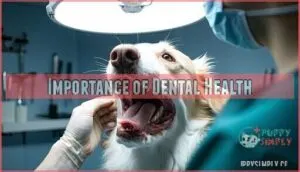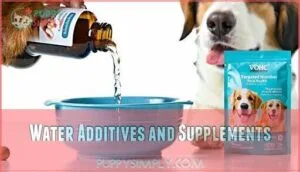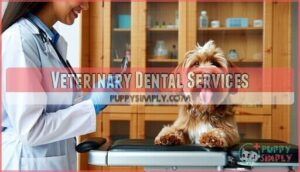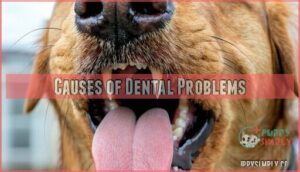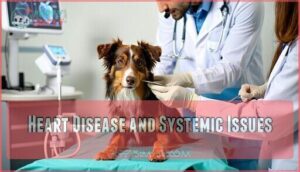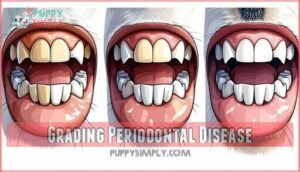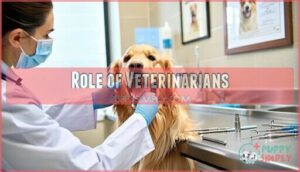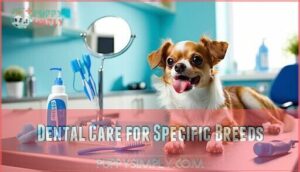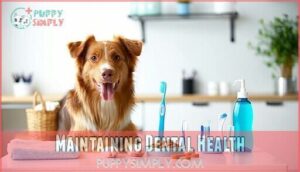This site is supported by our readers. We may earn a commission, at no cost to you, if you purchase through links.

Start by brushing your dog’s teeth with pet-safe toothpaste, offering dental chews, and using water additives. Professional cleanings remove tartar buildup that home care can’t reach.
Without proper care, bacteria from infected gums can travel to your dog’s heart, kidneys, and liver, causing serious health problems. Even small dogs need attention since their compact mouths crowd teeth together.
Simple daily habits can add years to your furry friend’s life while keeping those kisses sweeter, and this is achieved through regular dog dental care and preventing bacteria from causing harm.
Table Of Contents
- Key Takeaways
- Dog Dental Care Basics
- Importance of Dental Health
- At Home Dental Care
- Professional Dental Cleanings
- Veterinary Dental Services
- Causes of Dental Problems
- Effects of Periodontal Disease
- Role of Veterinarians
- Dental Care for Specific Breeds
- Maintaining Dental Health
- Frequently Asked Questions (FAQs)
- How much should a dog’s dental cleaning cost?
- Is dental care for dogs necessary?
- How much does dog dental treatment cost?
- What are some signs that my dog may have dental problems?
- How often should I brush my dog’s teeth?
- Are there any breeds that are more prone to dental issues?
- Can I use human toothpaste to brush my dog’s teeth?
- Is anesthesia necessary for professional dental cleanings for dogs?
- What age should I start dog dental care?
- How often should dogs get professional cleanings?
- Conclusion
Key Takeaways
- Start brushing your dog’s teeth 2-3 times weekly with pet-safe toothpaste – you’ll prevent 80% of dogs from developing periodontal disease by age three and avoid serious health complications affecting their heart, kidneys, and liver.
- Schedule annual professional dental cleanings under anesthesia because you can’t reach tartar buildup below the gumline at home, and these cleanings include essential X-rays that detect hidden problems like bone loss and infections.
- Watch for warning signs like bad breath, yellow tartar, red gums, difficulty eating, or pawing at their mouth – you’ll catch dental problems early and prevent costly emergency treatments that can range from $300-$1,500.
- Use VOHC-approved dental chews, water additives, and prescription dental diets between brushings because you’re creating multiple layers of protection that work together to control plaque and bacteria when you can’t brush daily.
Dog Dental Care Basics
Taking care of your dog’s teeth doesn’t have to be complicated when you know the basics.
The right approach combines proper brushing techniques, quality dental products, and regular maintenance to keep your pet’s mouth healthy and pain-free.
Brushing Dog Teeth
Brushing your dog’s teeth 2-3 times weekly prevents plaque buildup and maintains dog dental health.
Use enzymatic toothpaste with appealing toothpaste flavors like chicken or beef.
Large dogs need regular toothbrushes, while small breeds benefit from fingertip brush types.
Watch for aggression signs during dog teeth cleaning sessions. If your pet resists, consider brushing alternatives like dental wipes or sprays for effective dog oral hygiene maintenance.
Dog Toothpaste Options
Choosing the right canine toothpaste makes dog teeth cleaning easier and more effective.
Enzymatic toothpaste breaks down plaque through natural chemical action, while flavor preferences like chicken or beef encourage cooperation.
Safe ingredients avoid toxic compounds found in human products, and application methods range from traditional brushing to finger brushing for sensitive pets.
These brushing alternatives guarantee every dog receives proper oral care, and the enzymes in these toothpastes help break down plaque, making oral care more accessible.
Dental Chews and Treats
Dog dental chews and treats provide an easy way to support your pet’s oral health between brushings.
Look for VOHC approved products that contain chew ingredients proven to reduce plaque buildup.
Consider chew size carefully – treats should match your dog’s weight to guarantee treat safety.
Daily chews like OraVet create protective barriers against harmful bacteria, while products like Purina DentaLife actively work to prevent dog dental disease through mechanical cleaning action.
Importance of Dental Health
Your dog’s dental health directly impacts their overall well-being and can prevent serious health complications.
Poor oral hygiene doesn’t just cause bad breath—it can lead to heart disease, kidney problems, and painful tooth loss that affects your pet’s quality of life, which is why maintaining good oral hygiene is crucial.
Preventing Systemic Diseases
Beyond surface-level dental issues, poor oral health in your dog creates a dangerous pathway for oral bacteria to enter the bloodstream.
These systemic infections can silently damage essential organs, making preventive dental care indispensable for your pet’s overall wellness.
- Heart health deteriorates as bacteria from dental disease travels through blood vessels, potentially causing life-threatening cardiac complications
- Kidney impact intensifies when toxins from oral infections overwhelm your dog’s filtering system, leading to progressive organ damage
- Liver damage accelerates as this essential organ works overtime to process bacterial toxins, compromising its essential functions
- Systemic infections spread throughout your dog’s body, creating widespread inflammation that affects multiple organ systems simultaneously
Reducing Tooth Loss
Regular dental care prevents tooth loss by addressing dog dental disease before it progresses.
Early intervention through daily brushing, proper diet and teeth maintenance, and preventative measures stops periodontal disease from weakening tooth roots.
Plaque prevention and tartar removal protect gums from infection.
Some breeds have genetic predispositions requiring extra attention.
Quality chew toy safety guarantees natural cleaning without damage, which is crucial for daily brushing and overall dental care.
Improving Quality of Life
Quality dental care transforms your dog’s daily experience.
Pain reduction from healthy teeth and gums lets dogs eat, play, and interact comfortably.
Early intervention prevents dog dental disease from progressing to stages that cause chronic discomfort.
Preventative care supports systemic health, while proper diet impact maintains oral health, ensuring your companion enjoys life fully with proper diet.
At Home Dental Care
You can maintain your dog’s dental health between professional cleanings with simple at-home care routines. These methods help prevent plaque buildup and keep your pet’s mouth fresh and healthy.
Brushing Techniques
Starting with proper toothbrush selection sets you up for success.
Large dogs can use human toothbrushes, while small dogs need baby or fingertip brushes for comfort.
Apply dog toothpaste with chicken, beef, or peanut butter flavors to encourage cooperation.
Brush 2-3 times weekly using gentle circular motions.
Regular brushing also helps with distributing natural oils for a healthy coat.
Skip brushing if your dog shows aggression to avoid stress and maintain positive dental hygiene practices.
Dental Wipes and Sprays
Dental wipes and sprays offer convenient alternatives when dog teeth brushing isn’t possible.
These dog dental wipes use gentle wipe application to remove plaque and bacteria from teeth and gums.
Dog dental sprays contain safe spray ingredients that target harmful bacteria while providing breath freshening benefits.
Both dog oral care options support gum health without requiring restraint or training like traditional brushing methods.
Some pet owners find success using specialized dental products for their dog’s dental hygiene.
Water Additives and Supplements
When choosing between water additives and dental supplements for your dog’s oral health, you’re looking at effective yet convenient solutions.
Water additives work by simply mixing into your pup’s drinking bowl, while supplements offer targeted nutrition.
VOHC-approved products guarantee proven effectiveness. However, additive effectiveness requires consistent long-term use and works best after professional cleanings.
Some additives contain ingredients that help reduce oral bacteria levels. Follow dosage guidelines carefully for ideal veterinary dental care results.
Professional Dental Cleanings
While at-home care helps maintain your dog’s teeth, professional cleanings remain essential for complete oral health.
Your veterinarian uses anesthesia to perform thorough examinations, scaling, and polishing that reaches areas impossible to clean at home, which is crucial for oral health.
Anesthesia and Safety
Throughout professional veterinary dental cleanings, anesthesia safety relies on thorough protocols including pre-anesthetic bloodwork importance to assess organ function.
General anesthesia enables thorough examination while monitoring protocols track essential signs continuously.
Veterinary teams evaluate anesthesia risks carefully, though complications remain rare with proper preparation.
The recovery process includes supervised monitoring until pets regain normal function, ensuring ideal anesthesia safety outcomes, which is crucial for the overall well-being of the pets.
Tooth Scaling and Polishing
Once anesthesia guarantees your dog’s safety, the veterinary team begins the thorough dental cleaning process.
Tooth scaling removes stubborn tartar buildup from above and below the gum line, while polishing smooths microscopic scratches that bacteria love to call home.
Here’s what happens during professional scaling and polishing:
- Subgingival cleaning removes hidden plaque beneath the gums where home care can’t reach
- Ultrasonic scalers break apart tough tartar deposits through high-frequency vibrations
- Hand scaling targets stubborn areas and provides precise tartar removal
- Polishing purpose creates smooth tooth surfaces that resist future bacterial adhesion
The scaling benefits extend far beyond what you see.
While human dental scalers only address visible surface tartar, veterinary dental prophylaxis tackles the real problem lurking below your dog’s gum line.
To maintain good oral health, consider scheduling regular cleanings for your beloved pet.
Post-procedure care instructions will help maintain these freshly cleaned teeth until your next professional cleaning.
Dental X-rays and Exams
Your vet can’t see what’s hiding beneath your dog’s gums without dental X-rays during professional cleanings.
These X-rays reveal bone loss assessment, root evaluation, and hidden problems like fractures or infections.
More than half of each tooth sits below the gumline, making X-ray necessity clear for complete professional oral assessment.
Anesthesia risks are minimal with proper veterinary examination and pre-screening bloodwork beforehand.
Veterinary Dental Services
When your dog needs more than at-home brushing, veterinary dental services provide professional care that keeps serious problems at bay.
Your vet offers routine checkups, specialized procedures, and prescription diets that work together to maintain your pet’s oral health.
Routine Checkups
Regular dog dental checkups form the backbone of preventative care.
Your vet examines teeth and gums during routine visits, catching problems before they become costly emergencies.
Early detection through these veterinary examinations can save you hundreds in future treatments.
Most dogs need professional cleanings annually, though exam frequency varies by age and breed.
Some anesthesia-free options exist for basic maintenance between full cleanings.
Regular checkups are crucial for maintaining your dog’s oral health, and early detection can help prevent costly emergencies.
Dental Procedures and Surgeries
Sometimes complex dental procedures become unavoidable when routine care isn’t enough.
Your veterinarian might recommend tooth extractions for severely damaged teeth, root canals for infected roots, or gum surgery for advanced periodontal disease.
These veterinary dental procedures require anesthesia to guarantee your dog’s safety and comfort during treatment.
- Tooth extractions – When saving a tooth isn’t possible, removal prevents ongoing pain and infection
- Anesthesia risks – Modern monitoring makes dental procedures safer, though older dogs need careful evaluation
- Oral tumors – Early detection during dental exams can be life-saving for your furry friend
Prescription Dental Diets
Three top prescription dental diets transform dog dental care through specially designed kibble.
These veterinary-recommended foods reduce plaque buildup by up to 99% while providing complete nutrition.
Vets recommend brands like Hill’s t/d, which received VOHC approval for proven tartar reduction.
| Diet Brand | Key Kibble Benefits | Plaque Reduction Rate |
|---|---|---|
| Hill’s t/d | Fiber-matrix texture scrubs teeth | Up to 99% tartar reduction |
| Purina Pro Plan DH | Crunchy kibble promotes chewing | Clinically proven effectiveness |
| Royal Canin Dental | Strong fiber matrix maximizes cleaning | Breed-specific formulations |
| Generic Benefits | Mechanical cleaning action |
Supports gum health naturally.
Prescription dental food works like edible toothbrushes.
Diet ingredients include antioxidants and fiber blends that support gum health.
Veterinary nutritionists design these formulas to clean teeth up to the gum line during normal eating.
Causes of Dental Problems
Understanding what causes dental problems helps you protect your dog’s oral health before serious issues develop.
The three main culprits—periodontal disease, broken teeth, and dental infections—can lead to pain and costly treatments if left untreated.
Periodontal Disease
Periodontal disease silently attacks your dog’s mouth, creating painful inflammation that spreads below the gum line.
This bacterial infection progresses through disease stages, causing gum recession and bone loss around tooth roots.
- Stage 1: Gingivitis with red, swollen gums
- Stage 2: Early periodontitis with slight bone loss
- Stage 3: Moderate bone loss and gum recession
- Stage 4: Severe bone loss requiring tooth extraction
Bad breath signals oral bacteria buildup. Preventative measures through consistent dog dental care stop gum disease progression effectively.
Broken Teeth and Roots
Hard chewing on inappropriate objects causes dog dental fractures. Your pet might crack teeth on ice, bones, or rocks, creating painful breaks that expose sensitive inner structures.
Dental X-rays reveal hidden root damage that needs immediate attention. Raw bones are beneficial for canine dental health.
| Fracture Type | Common Causes | Treatment Required |
|---|---|---|
| Crown fracture | Ice cubes, antlers | Extraction or root canal |
| Root fracture | Hard bones, rocks | Complete tooth removal |
| Slab fracture | Tennis balls, sticks | Pain management, extraction |
| Vertical split | Compressed rawhide | Immediate surgical removal |
| Chip fracture | Metal cage bars | Smoothing, monitoring |
Extraction becomes necessary when fractures reach the tooth’s root or cause severe pain. Treatment options include pain management medications and surgical removal to prevent further complications.
Abscesses and Infected Teeth
Abscessed teeth develop when bacteria enter through broken teeth or deep periodontal pockets, creating painful pus-filled infections.
You’ll notice symptoms like facial swelling, bad breath, drooling, or reluctance to eat.
Treatment requires antibiotics and often tooth extraction to prevent complications.
Proper dog dental care and regular cleanings help prevent oral infections from spreading to essential organs and are crucial for overall health, making regular cleanings a vital part of dog care.
Effects of Periodontal Disease
Periodontal disease doesn’t just damage your dog’s mouth – it creates serious health problems throughout their body.
When bacteria from infected gums enter the bloodstream, they can affect essential organs like the heart, kidneys, and liver.
Kidney and Liver Problems
When bacteria from periodontal disease enter your dog’s bloodstream, they can seriously damage essential organs.
Poor oral hygiene creates dangerous pathways for bacteria to damage your dog’s heart, kidneys, and liver.
These systemic infections create toxin effects that overwhelm your pet’s filtering systems, potentially leading to organ damage and disease progression.
Here’s how kidney disease and liver disease develop:
- Kidney Disease – Bacterial toxins damage filtering units, reducing waste removal efficiency
- Liver Failure – Infected blood overwhelms the liver’s detoxification processes
- Systemic Health Issues – Both organs struggle to maintain normal body functions
Proper dog dental care prevents these life-threatening complications.
Heart Disease and Systemic Issues
Bacteria from infected gums can spread throughout your dog’s body, creating serious health complications.
When harmful bacteria enter the bloodstream through diseased gums, they can damage essential organs and trigger dangerous inflammatory responses that affect your pet’s overall health.
| Affected System | Health Risk | Potential Outcome |
|---|---|---|
| Cardiovascular | Cardiac Risks | Heart valve damage, irregular heartbeat |
| Circulatory | Blood Disorders | Bacteremia, blood clots, sepsis |
| Multiple Organs | Organ Damage | Kidney disease, liver disease complications |
Grading Periodontal Disease
Veterinarians classify periodontal disease into four distinct stages to determine proper treatment.
Stage 1 shows gingivitis with gum inflammation but no tooth loss.
Stage 2 reveals early periodontitis with minor attachment loss.
Stage 3 displays moderate bone destruction and increased tooth mobility.
Stage 4 presents severe periodontitis with significant tooth loss and bone damage requiring immediate intervention.
Role of Veterinarians
Your veterinarian plays a vital role in maintaining your dog’s dental health through professional expertise and specialized equipment.
They perform thorough dental examinations, recommend appropriate treatments, and guarantee your pet receives thorough oral care that goes beyond what you can provide at home, ensuring your dog receives thorough care.
Performing Dental Procedures
Your veterinarian performs dental procedures under general anesthesia to guarantee complete safety and thorough treatment.
During professional dental cleanings, they use specialized tools for dental scaling and plaque removal above and below the gumline.
X-ray analysis reveals hidden problems requiring tooth extraction or advanced care.
Unlike anesthesia-free dental cleanings, veterinary dental care addresses the entire tooth structure through proper dog dental procedures and thorough dental cleaning procedures.
Recommending Treatments
After thorough examination, your veterinarian becomes your trusted guide in crafting personalized dental treatment plans.
Professional dental cleanings with tooth scaling provide the foundation, while veterinary guidance helps you choose appropriate solutions:
- Dental chews and oral supplements for daily plaque control
- Prescription diets designed for canine dental health
- Water additives and specialized veterinary dental recommendations
Ensuring Overall Oral Health
Looking beyond daily brushing, your veterinarian guarantees thorough oral health through systematic monitoring and preventive strategies.
They track gum health, assess jaw alignment, and detect early tooth decay signs during regular checkups.
| Oral Health Component | Veterinary Assessment |
|---|---|
| Gum Health | Monitor inflammation and recession |
| Tooth Decay | Identify cavities and surface damage |
| Jaw Alignment | Check bite patterns and positioning |
| Oral Hygiene | Evaluate plaque buildup and tartar |
Your vet recommends dental diets customized to your dog’s specific needs, creating a complete canine dental health plan that goes beyond basic pet oral hygiene routines.
Dental Care for Specific Breeds
Not all dogs face the same dental challenges, and certain breeds require extra attention to maintain healthy teeth and gums.
Small breeds like Chihuahuas and Yorkshire Terriers, along with flat-faced dogs such as Bulldogs and Pugs, are especially prone to dental problems that need specialized care approaches.
Small and Brachycephalic Breeds
Small breeds and brachycephalic breeds face unique canine dental issues due to their facial anatomy and jaw structure.
Forty-two adult teeth crowding into tiny mouths creates serious bite issues and tooth alignment problems that accelerate tooth decay.
- Overcrowded teeth in Chihuahuas and Yorkies trap more plaque between surfaces
- Shortened skulls in Bulldogs and Pugs cause misaligned teeth and jaw structure problems
- Compact jaws reduce natural cleaning action, requiring extra breath control measures
- Tooth rotation and spacing issues make standard brushing techniques less effective
- Earlier disease onset means small breeds need proactive dog dental care starting younger
Breed-Specific Dental Issues
Different dog breeds face unique dental challenges due to their genetics and physical traits.
Understanding these breed-specific issues helps you provide better oral care for your furry friend.
| Breed Type | Common Dental Issues |
|---|---|
| Bulldogs & Pugs | Crowded, misaligned teeth from shortened skulls |
| Poodles & Maltese | Tooth overcrowding, retained baby teeth |
| Chihuahuas & Yorkies | 42 teeth crammed into tiny mouths |
| Boxers & Collies | Gingival hyperplasia from plaque buildup |
| Dachshunds | Deep periodontal pockets in narrow muzzles |
Canine genetics play a major role in determining your dog’s dental destiny.
Brachycephalic breeds often develop traumatic underbites, while small breeds struggle with overcrowded teeth that trap plaque.
This reorganization improves readability by grouping related concepts together, making it easier to understand the unique dental challenges faced by different dog breeds and the importance of breed-specific care.
The table highlights common dental issues for various breeds, including gingival hyperplasia and deep periodontal pockets.
Preventative Care for Prone Breeds
Managing dental health for prone breeds requires targeted preventative measures that address genetic factors and breed-specific risks.
Daily brushing with pet-safe toothpaste works best for small and brachycephalic breeds.
Professional cleanings should start earlier and occur more frequently. Dental chews, specialized diets, and water additives help control plaque between cleanings.
Early intervention prevents costly treatments later. Regular dental care checks are essential for maintaining ideal oral health in dogs.
Maintaining Dental Health
Maintaining your dog’s dental health requires consistent effort both at home and through regular veterinary care.
By combining daily brushing, dental treats, and professional cleanings, you’ll keep your dog’s teeth strong and prevent serious health problems.
This approach ensures that your dog receives complete care, addressing all aspects of dental health to prevent issues.
Regular Veterinary Visits
Your veterinarian becomes your dog’s dental health partner through regular checkups.
Professional dental exams catch hidden problems early, preventing costly treatments later.
Schedule these important visits:
- Annual vet checkups with thorough oral examinations
- Dental exams every 6-12 months for high-risk breeds
- Professional dental cleanings under anesthesia as recommended
- Follow-ups after dental procedures to monitor healing
Pet insurance often covers veterinary dental care, making regular visits more affordable.
Your vet’s recommendations guide effective home care between professional cleanings.
At-Home Care and Maintenance
Daily tooth brushing reduces plaque formation by 60%.
Use dog-specific toothpaste and brushes for safety.
VOHC-approved dental chews decrease tartar buildup substantially while water additives help control oral bacteria between brushing sessions.
| Method | Frequency | Effectiveness |
|---|---|---|
| Tooth Brushing | Daily | 60% plaque reduction |
| Dental Chews | 2-3 times weekly | 69% tartar decrease |
| Water Additives | Daily | Bacterial control |
Monitoring Dental Health and Progress
Between professional cleanings, you’ll want to keep tabs on your dog’s oral health progress.
Weekly dental checks help you spot trouble before it becomes costly.
Here’s what to monitor:
- Visual signs – Check for red, swollen gums, yellow tartar buildup, or persistent bad breath that signals developing gum disease
- Behavioral changes – Watch for dropped food, reluctance to chew, or excessive drooling that indicates oral pain
- Progress tracking – Document findings to help your veterinarian evaluate how well your plaque control efforts are working
Regular tooth monitoring guarantees your canine dental hygiene routine stays effective and catches issues early.
Frequently Asked Questions (FAQs)
How much should a dog’s dental cleaning cost?
Dog dental cleanings typically cost $300-$1,500, depending on your location, clinic type, and your dog’s needs. Basic cleanings cost less, while extractions or advanced procedures increase expenses substantially.
Is dental care for dogs necessary?
An ounce of prevention’s worth a pound of cure when caring for your pet’s health.
Yes, dental care’s absolutely necessary for dogs.
Poor oral health causes pain, tooth loss, and serious infections affecting the heart and kidneys, making regular brushing and professional cleanings essential.
How much does dog dental treatment cost?
Veterinary dental cleanings typically cost $300-$1,500 depending on your dog’s size, location, and needed procedures. Extractions, X-rays, and anesthesia add extra costs, making prevention through daily brushing worthwhile.
What are some signs that my dog may have dental problems?
Over 80% of dogs show signs of dental disease by age three.
Watch for bad breath, yellow tartar buildup, red or swollen gums, difficulty eating, pawing at their mouth, or loose teeth.
How often should I brush my dog’s teeth?
Brush your dog’s teeth 2-3 times weekly, or daily if they tolerate it well. This frequency effectively removes plaque buildup and maintains ideal oral health between professional cleanings.
Are there any breeds that are more prone to dental issues?
Like canaries in coal mines, certain breeds signal dental danger early.
Yes, small breeds and brachycephalic dogs face higher risks.
Their cramped mouths create perfect breeding grounds for bacteria, making regular dental care absolutely essential for these vulnerable pups.
Can I use human toothpaste to brush my dog’s teeth?
No, you can’t use human toothpaste on your dog.
It contains xylitol and other ingredients that are toxic to dogs.
Instead, use dog-specific toothpaste that’s safe to swallow and comes in flavors dogs enjoy.
Is anesthesia necessary for professional dental cleanings for dogs?
When Max, a golden retriever, needed his first professional cleaning, his owner learned that anesthesia isn’t just recommended—it’s absolutely necessary.
You can’t safely clean below the gumline or take dental X-rays without anesthesia ensuring your dog stays still.
What age should I start dog dental care?
Start dental care when your puppy’s around four to six months old. Early introduction helps them get comfortable with brushing and sets the foundation for lifelong oral health habits.
How often should dogs get professional cleanings?
Think of your car’s oil changes—they’re scheduled maintenance that keeps everything running smoothly.
Most veterinarians recommend annual professional dental cleanings under anesthesia for dogs, though some may need them more frequently based on their individual oral health needs.
Conclusion
Something’s lurking in your dog’s mouth that could silently damage their entire body.
Your commitment to consistent dog dental care makes all the difference between a healthy, happy pet and costly veterinary emergencies.
Daily brushing, regular professional cleanings, and quality dental products protect against periodontal disease that affects most dogs.
Don’t wait until problems develop—start your dental routine today, as your dog’s heart, kidneys, and overall health depend on the preventive steps you take now.

